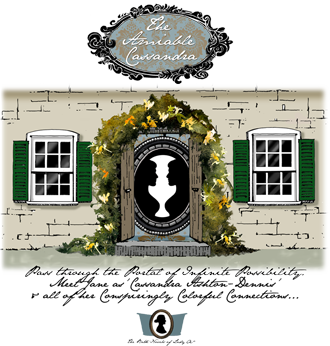Pug's Mug™

About the Author
Lady A~ is merely A~ Lady...
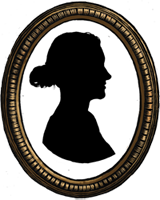
A shade of something ‘Lady A—’ always lurked in this lady‚ and though she would ignore it‚ it would not be ignored. Taking up her pen at last‚ some fifteen years ago‚ she answered a lively mind‚ not quite at ease‚ and saw everything. She now brings readers seven original novels full of captivating characters that are both trusty and troublesome‚ enough to sate even the most discriminating Janeite minds‚ and all in one exquisite domain—welcome dear friends to The Bath Novels of Lady A~!(TBNLA)!
The Amiable Cassandra is the second of seven Bath Novel ‘Classic Companions’. In it Lady A~ renders the remarkable life of Jane Austen as only she might have wittily penned it in fiction—for herself—for her allies—and‚ notably‚ for her enemies...
Here Fond Friends, you will meet a splashing of the complex and colorful characters of TAC‚ and in a very ‘novel’ way. Lady A~ will show how they were drawn in her imagination and how Jane Austen’s influence subtly colored every stroke of the fine brush that crafted these fascinating characters in profile. 
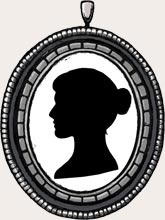
Cassandra Ashton-Dennis
So many iterations of Jane have fallen from pens and landed on screens to amuse us all‚ and surely since Colin Firth made his most manly splash in the Pemberley pond to reignite our fervor over all things ‘Jane’. But what if Jane‚ poised with the pen in her hand‚ wrote herself very wittily into fiction? What name would she employ as a pseudonym and what tales could she weave from the myriad of event and experience proffered to her through a wealth of connections both in the persons of family and friends? TBNLA‚ as a conceit‚ offers this very tantalizing possibility. A controversial ‘Jane’ secretly creating a collection of seven ‘dissident’ novels‚ begun in Bath and completed in Winchester‚ would most certainly have watched every high and low event‚ every quirk of character during the course of her exceptional life—and recorded it. Certainly‚ there was a fine story to be told: from the neighbors who had fetishes for ‘black jobs’, to love-child Francophile cousins enigmatically connected to powerful brokers of the Empire‚ to brothers who found their respective fortunes purely by luck or by merit alone.
And what of Jane’s forays into love? So much did she write of love and marriage‚ why wouldn’t she imagine a masterly match of her own‚ fraught with all the tensions and trials that make the likes of the Dashwoods‚ Bennets and Bertrams so very intriguing? When she entered her name‚ as a child‚ in her father’s parish register as having married a ‘Jack Smith’‚ a ‘Henry Frederic Howard Fitzwilliam of London’ and a ‘Edmund Arthur William Mortimer of Liverpool’‚ this made me think she was indeed beginning to concoct stories not just for the amusement of others and the sheer joy of writing‚ but she was entertaining ideas of love for herself. Who cannot imagine‚ for instance‚ that Miss Eliza Bennet was as much a part of Jane as the authoress herself?
So why not an undisguised distinct ‘Jane’ as a version of herself‚ living in a world that reinterprets or recreates the experiences and connections we have scrutinized so relentlessly‚ in order to get a glimpse of an elusive prodigy. In short‚ an alter-ego Jane in a mirror-microcosm of the actual Regency world that Austen (fondly called ‘Lady A—’) lived in as an intrepid female novelist. Indeed‚ what could be possible if one walked through such a portal to meet such a creature? So many of the attempts at portraying Jane as herself‚ both factually and fictitiously‚ in literary fiction and in film‚ have not suitably satiated our desires in imagining her in true dimension. And this is because a redrawing of the real Jane‚ without disguise‚ constricts perception because it is governed by a set of slim facts that suggest rather than support the notion that we really understand the truths of her history. Treading on such ephemeral and sacred ground‚ I decided rather to draw the progenitor of all this conjecture into a heroine that everyone would at once recognize‚ but still hold as impervious to the hubris of quizzing penetration. The key was not to match Jane with fiction‚ but to make fiction out of Jane.
Choosing a name for this bewitching creature also came from the ‘mirror’ concept of Jane looking into ‘Jane’. The best known ‘better half’ of Jane was not any lover‚ but rather her closest companion‚ confidant and sister‚ Cassandra Elizabeth Austen. Each complemented the other and without Cassandra’s input‚ it is hard to imagine Jane would have developed her genius so completely. Who better then‚ to name the fictional Jane after but her sister? And what then of my heroine’s last name? Jane used the pseudonym ‘Mrs Ashton Dennis’ when corresponding with her feckless publisher‚ Richard Crosby‚ and it seemed a perfect choice to salute the real Jane in a subliminal but deferent way.
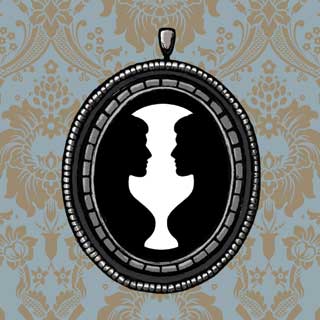
Now enter the very amiable Cassandra. ‘A lady’ now malleable enough to find herself in a story familiar to all die-hard Janeites acquainted with Jane Austen’s history‚ but driven by literary license that permits a host of infinite possibilities with finite facts. To such end‚ my Cassandra becomes the protagonist of a story that unfurls within and out of Jane’s history and the evolution of her six perfect classics. Seemingly‚ and according to the TBNLA conceit‚ Austen as ‘Lady A—’‚ has taken all of these elements of mystery and magic and made them her own in an entrancing tale where person‚ place‚ creation and event transforms into a story fit for the incomparable ‘imaginist’ herself: A gift of possibility most plausibly guided by ‘her’ hand. And by such means the fulfilment in love that we all secretly wish for our intangible Jane becomes a very tangible quest'‚ and without ever having to tamper with the integrity of her true fate and fame.
With such license to hand may I now introduce you'‚ Fond Friends'‚ to a most dazzling hero and a ‘matchless match’ for my unmatched heroine…
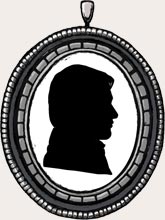
John Lascelles
What sort of man could capture the mind‚ interest and heart of a prodigy? In Jane Austen’s case there were two who reached the very high bar of her imagination: Thomas Langlois Lefroy was one such man‚ Anne Lefroy’s [J A’s close friend and mentor] Irish nephew‚ and the other was a (mysterious) gentleman whom it was conjectured she fell in love with while visiting Teignmouth with her parents and sister in 1802. Indeed‚ Cassandra Austen thought that there was definitely ‘a mutual attachment’ in progress regarding the latter.
In creating a hero for Jane’s counterpart in fiction‚ Cassandra Ashton-Dennis‚ my hero needed to be comprised of more than one man. He needed to be larger than life and fuller than fiction. I required the real characters and histories of both of the most significant of Austen’s romantic interests‚ and all of Austen’s heroes. Though not very much is known about Lefroy and the mysterious man from Teignmouth (whom‚ for the record‚ I do not believe is Revd Samuel Blackall*‚ as recently speculated) there was enough in these encounters to create the basis for the literary DNA of a hero. The addition of elements of a Darcy‚ Brandon‚ Bertram‚ Knightley‚ Tilney and Wentworth then made him wholly complete. Just as I believe Jane was creating stories in which she could experience the fictional fulfilment of love through her characters‚ the male protagonists she created were no doubt extensions of the ‘Smith’‚ ‘Fitzwilliam’ and ‘Mortimer’ she fantasized about as a child in her father’s parish register. And‚ perhaps‚ even reworked sketches of the two men who had happened to touch her heart?
Enter John Lascelles. When my heroine‚ Cassandra‚ first sees him‚ he blazes into a ballroom as ‘dazzling’ comet. Having been somewhat prepared for his glorious good looks through awe-inspiring accounts from her family and friends‚ and having seen him depicted in a painting of her brother Lawrence’s Grand Tour‚ she is at least collected enough to stand her ground. But like so many before and around her‚ there is no doubt that she cannot be left ‘untouched’. To have my heroine feel unequivocally about a man who is so evidently a veritable ‘demi-god’ was as necessary to his qualifications as a hero as it was likely that he could not fail to inspire such a reaction in any feeling creature. That he is as ‘a work of art’ is symbolic on several levels. As one of The Amiable Cassandra’s main themes reality vs. appearance suggests‚ there is much more to Lascelles’s mesmerizing ‘manly graces’ than meets the eye. He is full of layers that require greater understanding and analysis. He is not just an inordinately handsome man who can make conquests when and where he pleases‚ but rather a man that is looking for an equal in intellect‚ ideal and ideology—a representation of everything Austen wrote into her heroes‚ and no doubt felt flashes of on meeting with Lefroy and the gentleman from Teignmouth.
Lascelles has already seen the beauty of Cassandra’s mind in having read and feted her books. He‚ therefore‚ has (also) had his anticipation temptingly wheted by a most unusual creature—a female novelist. And what is the first thing he notices about her looks as he brings her into view while swooping down on the throng of the Heathmore Ball? That ‘her mesmerizing air of sentience’ reveals ‘something of her remarkable perspicacity’. This is what has first attracted his intellect in initially meeting her mind in the realm of her books. He is disposed to have the rest of his ‘first impressions’ informed by this inclination‚ and thus Cassandra’s ‘lively intelligent‚ hazel eyes’ become things of beauty within themselves; enough even to capture the interest of a worldly and complex hero. As the two protagonists encounter each other for the first time‚ then‚ that theirs is a ‘marriage of true minds’‚ the reader cannot be in any doubt.
Fundamentally Lascelles becomes another aspect of ‘Jane looking into Jane’. Answering all the Austen-hero criteria‚ he most significantly finds the concept of a woman ‘unequivocally’ asserting ‘herself into a profession where mostly men were her peers’ the main motivation behind his fascination. In so doing‚ he is truly acknowledging the beguiling power of his ‘progenitor’. He is saluting Jane through Cassandra‚ as if he is the ideal counterpart to such a prodigy‚ by comprising all that Jane imagined a hero to be in the scope of her creative and life’s experience. In such a way‚ ‘Smith’ through-Lefroy-through-Darcy have at last transcended the parish register‚ the record of history and the novel to pass through the portal to reach out to the genius of Jane.
John Lascelles is most faithfully the prize fostered by Jane Austen’s dazzling gift…
* Revd Samuel Blackall was an unappealing yet marriageable acquaintance of Anne Lefroy.
PURCHASE & POSSESS
the very novel The Amiable Cassandra. 


